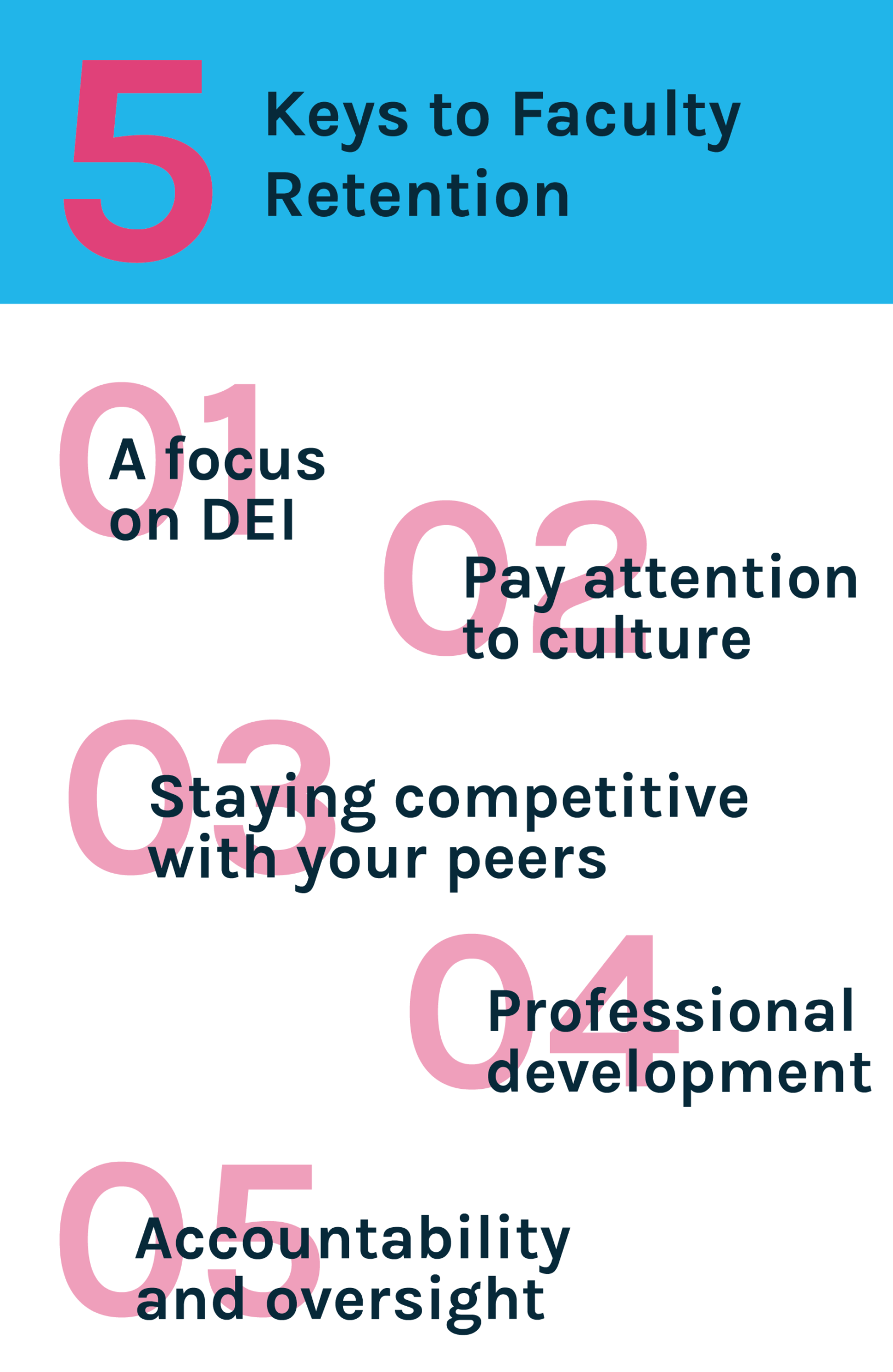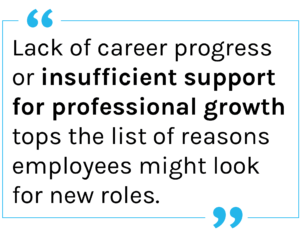Why do we need to think about faculty retention?
Higher education has historically been a sector that did not struggle to keep or hire employees in both faculty and staff roles, as such, faculty retention hasn’t always been a top priority. The Chronicle of Higher Education noted in a recent piece that colleges and universities were highly regarded places to work, relatively immune to recessions, and always fielding more than enough applicants for open roles. As the Chronicle wrote, “Why try hard to retain someone if you can always count on a deep pool of applicants?”
The climate has changed, however. In one poll, 55% of faculty reported having seriously considered retirement or a career change since 2020. In addition, more than 2/3 of faculty polled felt extremely stressed, compared to 2019—a sign of burnout. Many faculty and staff members were asked to take on more work during the pandemic, and many faculty had to learn new teaching methods or teaching platforms overnight. The great resignation is impacting HigherEd, and it’s time to take a hard look at faculty retention.
1. A focus on DEI
The loss of talent in the workforce in the last several years has not been evenly distributed.
- SHRM reported that nearly 1.1 million women left their jobs between February 2020 and January 2022.
- In HigherEd, data from CUPA-HR shows that women and minorities are still underrepresented among tenure-track faculty.
- Female faculty were disproportionately impacted by the pandemic, sacrificing research to balance increased caregiving responsibilities and core faculty responsibilities.
- Women academics published fewer papers than men during the pandemic—and research is vital for any professor hoping to get tenure.
These issues are only an exacerbation of the “leaky pipeline” issues that have historically faced women and minorities on the tenure track at many universities. Women and faculty of color are more frequently called upon to perform service work, but receive little recognition or reward for sacrificing their research hours for service. Women and minorities facing roadblocks to reaching tenure or facing bias at their institutions are likely to join the leaky pipeline, leaving academia or your institution for good.
Tackling these issues is a complex undertaking, but there’s a place to start: examine the data. Look at the EEO metrics of your hiring pools when recruiting for new faculty roles. Start closely tracking your promotion and tenure information with a Faculty Information System to uncover biases in those processes. Use faculty data to examine workload and service hour distribution. Use all of this information to launch DEI initiatives that solve the unique challenges your institution is facing. Show your faculty that you’re listening and responding to the struggles they’re facing, and you’ll inspire those on the fence to stay.
2. Pay attention to culture
As noted earlier, faculty are burned out. Being asked to teach in new ways, and sometimes to use two teaching modalities in one classroom, all while navigating a global pandemic and the regular pressures of teaching and research—it’s just too much. Faculty noted that HigherEd institutional leaders need to not just acknowledge the challenges faculty are facing right now, but take actionable steps to address those problems. Frequent communication with faculty about expectations for teaching modalities or event attendance, for instance, means that everyone has the information they need and faculty won’t feel blindsided by decisions. Additional support for childcare responsibilities, stopping the tenure clock, considering extra leave, or offering extra IT support for new teaching platforms are all signs that your institution is focused on the well-being of faculty. Demonstrate your commitment to faculty by including them in decisions about the adoption of new technology and engage in change management tactics. Help your faculty recover from a difficult time, and you’ll be rewarded with retention.
3. Staying competitive with your peers
Studies have reported that feeling underpaid is a top factor that motivates people to leave their jobs. Academia is no exception, and with many HigherEd institutions facing budget cuts and faculty salaries decreasing, it’s important to think about remaining competitive with your peer institutions. PeopleAdmin’s Talent Intelligence brings anonymous, market-wide analytics on position, hiring, and performance trends, organizational growth, and common challenges by leveraging data throughout the customer base. Benchmark your institution against your peers and view trends across the HigherEd industry to make sure you’re doing the best for your faculty.
4. Professional development
Professional development and paths for career growth are vital to any employee retention effort. Lack of career progress or insufficient support for professional growth is at the top of the list of reasons employees might look for new roles. Ensuring that faculty have the tools to improve their teaching skills or engage in research that could broaden their knowledge base shows that your institution is invested in their long-term success—which in turn encourages faculty to be invested in a long-term career at your institution. A small investment in DEI or bias reduction training can have a large impact on a culture of inclusivity on campus, potentially plugging some of the “leaky pipeline” towards tenure mentioned earlier. In addition, be sure to offer faculty clear paths to grow into leadership positions on campus, encouraging growth, high performance, and retention.
5. Accountability and Oversight
Performance reviews, while a staple of many organizations, are not a one-size-fits-all solution. This is especially true when it comes to faculty at your HigherEd institution. A yearly review might force faculty into a box, analyzing job performance on metrics that don’t suit the faculty’s actual work. Still, it’s important for faculty to be accountable and examine their job performance, so that they can understand where they’re excelling or where they might need to improve. Transparency and accountability ultimately help increase retention, so how can HR ensure that these processes are working?
With a performance management solution specifically built for HigherEd, your office can ensure a fair, transparent process for faculty. Even without being directly involved in these reviews, an HR team can use the Performance Management module to make sure the process is happening all over campus, and know that faculty have the information and feedback they need to do their jobs well. Performance Management allows each department to create the feedback loops that work for them. Our software understands that faculty work can span years, so a traditional yearly evaluation might not make sense—schedule feedback on the timeline that works best for every faculty member. Bring transparency to a process that works for your institution to boost faculty retention.
Start focusing on retention today!
With these five keys to faculty retention, your team can dive right in. To take your retention efforts to the next level, schedule a demo with PeopleAdmin today.

